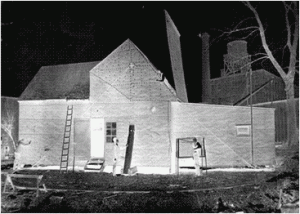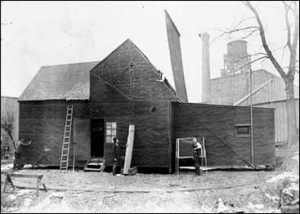newark athlete
martinetti contortion
 a cellebration of the moving image,
a cellebration of the moving image,
time-based media and eternity.
.
Thomas Seest – Tilføjelser
Copenhagen 2002
 .
.
.
The Black Maria Studio
The tar-papered Black Maria was the color of a police paddy wagon, hence its nickname. It was even painted black on the inside. Part of its roof opened on hinges to allow the sun to shine upon the shooting stage. Sunlight was the only light source strong enough to register an image on the slow film emulsion of the day. If the sun happened to be on an inconvenient side of the Black Maria, the building was simply rotated on casters to face in the proper direction.
The shooting stage was tiny – barely 12 feet square. Facing the stage was a huge wooden camera – officially called the “Kinetograph. The camera was so large, in fact, that it took two strong men to manhandle it. For this reason, it was never removed from the building and always pointed in one direction. If a close shot was needed, the subjects simply moved toward the camera.
The first motion picture studio in America opened in December, 1892. Thomas Edison, who had built the unwieldy gizmo, called it by the genteel name, the “Kinetographic Theater.” But it was known far and wide by its more descriptive moniker, the “Black Maria.”
It was in the Black Maria that some of the first movies were filmed. They were short productions, none of them exceeding about 30 seconds. The films were designed to be shown in the Kinetoscope, a peep show device.
essay by Charles Edwin Price – Library of Congress 2001
The Kinetograph and the Kinetoscope were patented in 1891.
The Black Maria closed in 1901.